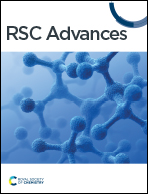Effect of carbon on the co-presence of metallic tungsten as a nucleation agent and Eu2+ in glass: crystallization of CaO–Al2O3–SiO2 glass probed with Eu2+ luminescence
Abstract
This study demonstrated simple redox control in glasses by improving the method used to added glass raw materials. Specifically, the effect of carbon on the co-presence of metallic tungsten (W) particles as nucleation agents and Eu2+ ions in CaO–Al2O3–SiO2 (CAS) glass was investigated via their crystallization to form CAS glass-ceramics (GCs). In this study, the glass specimens were prepared by mixing glass cullet containing metallic W particles and Eu2+ ions, respectively, with a glass batch containing carbon. Whereas the glass specimen was yellowish because of the presence of Eu2+ when carbon was not added during the remelting process, the glass specimen prepared with carbon was black because of the presence of metallic W particles. In addition, this specimen displayed the 470 nm emission band in its fluorescence spectrum recorded under 393 nm excitation, which was attributed to the presence of Eu2+. According to the fluorescence and transmission spectra, the glass specimen showed a darker coloration and more intense 470 nm emission band compared with the specimen prepared by the conventional melting method that included a remelting process. These results indicated that metallic W and Eu2+ were reduced with greater efficiency by the melting method that involved mixing the glass cullet and batch. In addition, the heat-treated glass specimen prepared by the aforementioned mixing method contained a greater amount of metastable CaAl2Si2O8 with increasing heat treatment time as revealed by X-ray diffraction analysis and scanning electron microscopy observation. The intensity of the 470 nm emission band decreased with increasing intensity of the band at 420 nm because of the incorporation of Eu2+ into the crystalline phase, and the increase in intensity of the 420 nm band was lineally proportional to the volume fraction of the crystallized glass specimens. The results therefore indicated that the co-presence of metallic W particles as nucleation agents and Eu2+ as a probe for tracking the crystallization process was achieved by the addition of carbon during the remelting process of mixed cullet containing W and Eu2+ through crystallization of the CAS glass. The results thus demonstrate the importance of improving the method used to added glass raw materials.



 Please wait while we load your content...
Please wait while we load your content...